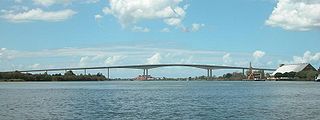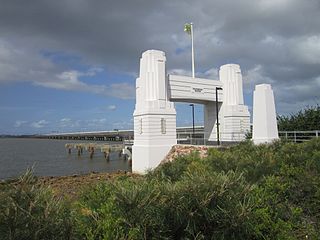
The Sir Leo Hielscher Bridges, formerly and still collectively referred to as the Gateway Bridge, are a pair of twin road bridges that carry the Gateway Motorway (M1) over the Brisbane River, skirting the eastern suburbs of the city of the same name. The western bridge carries traffic to the north and the eastern bridge carries traffic to the south. They are the most eastern crossings of the Brisbane River and the closest to Moreton Bay, crossing at the Quarries Reach and linking the suburbs of Eagle Farm and Murarrie. The original western bridge was opened on 11 January 1986 and cost A$92 million to build. The duplicate bridge was opened in May 2010, and cost $350 million.

The Story Bridge is a heritage-listed steel cantilever bridge spanning the Brisbane River that carries vehicular, bicycle and pedestrian traffic between the northern and the southern suburbs of Brisbane, Queensland, Australia. It is the longest cantilever bridge in Australia.

Hornibrook Bridge is a heritage-listed mostly-demolished road bridge on the Hornibrook Highway over Hays Inlet at Bramble Bay from Brighton, City of Brisbane to Clontarf, City of Moreton Bay, Queensland, Australia. It was designed by Manuel Hornibrook and built from 1932 to 1935 by Manuel Hornibrook. It was added to the Queensland Heritage Register on 7 October 1994.
Transurban is a road operator company that manages and develops urban toll road networks in Australia, Canada and the United States. It is listed on the Australian Securities Exchange (ASX), and is the world’s largest toll road operator.
The Gateway Motorway is a major tolled motorway in Brisbane, Queensland, Australia which includes the Sir Leo Hielscher Bridges. The motorway is operated by toll road operator Transurban.

The M2/M6 Logan Motorway is a 30-kilometre toll road between Ipswich and the M1 or Pacific Motorway at Loganholme, and the Gateway Motorway, providing access to the Gold Coast on the eastern seaboard and to the rural areas of the Darling Downs to the west. The M6 portion runs from the Pacific Motorway to the junction with the Gateway Motorway at Drewvale, where it then becomes the M2, continuing on to merge with the Ipswich Motorway at Gailes.
TransApex was a road transport plan devised by Brisbane Lord Mayor Campbell Newman in the early 2000s to connect existing motorways and major arterial roads with new transport links and divert cross-city traffic out of the Brisbane central business district. The plan is currently being delivered by Brisbane City Council at an estimated total cost of over $10 billion across five stages. According to the Brisbane City Council website, TransApex is "the biggest urban road project proposed in Australia".

The M7 Clem Jones Tunnel (CLEM7), known during its development as the North–South Bypass Tunnel (NSBT), is a A$3.2 billion motorway grade toll road under the Brisbane River, between Woolloongabba and Bowen Hills in Brisbane, Queensland. The tunnel was progressively opened to traffic from late on 15 March 2010 until just after midnight on 16 March 2010. It was completely open by 12:02 am.

The Airport Link is a tunnelled, motorway grade, toll road in the northern suburbs of Brisbane, Queensland, Australia. It connects the Brisbane central business district and the Clem Jones Tunnel to the East–West Arterial Road which leads to the Brisbane Airport. It was built in conjunction with the Windsor to Kedron section of the Northern Busway in approximately the same corridor.

Coronation Drive, popularly known as Coro Drive, is a road in Brisbane, Queensland, which connects the Central Business District to the suburb of Toowong. It follows the Brisbane River from the Riverside Expressway, through the suburbs of Milton and Auchenflower, until it terminates in Toowong at Benson Road and High Street.

The M3 Inner City Bypass (ICB) is a 5.6-kilometre (3.5 mi) major motorway standard bypass in Brisbane, Queensland, Australia. Bypassing the Brisbane central business district to the north, it connects Brisbane's Pacific Motorway and Go Between Bridge at Hale Street to Kingsford Smith Drive, Legacy Way Tunnel, Clem Jones Tunnel, AirportLink Tunnel and Lutwyche Road following the Exhibition railway line for the majority of its length.

The road transport in Brisbane, Australia, consists of a network of highways, freeways and motorways. Some motorways have tolls applied.

Queensland Motorways was the company that managed the 70-kilometre-long Linkt network of tolled roads in Brisbane which includes the: Clem Jones Tunnel (CLEM7), Go Between Bridge, Gateway Motorway and Logan Motorway. It had its headquarters at Eight Mile Plains.

The Kurilpa Bridge is a A$63 million pedestrian and bicycle bridge over the Brisbane River in Brisbane, Queensland, Australia. The bridge connects Kurilpa Point in South Brisbane to Tank Street in the Brisbane central business district. In 2011, the bridge was judged World Transport Building of the Year at the World Architecture Festival.

Kingsford Smith Drive is a major road in Brisbane. The road was named after the aviator Charles Kingsford Smith. It connects the suburb of Pinkenba to the Brisbane central business district at the Breakfast Creek. Kingsford Smith Drive is one of the busiest roads in Brisbane, carrying an average of 61,773 vehicles per day between July and December 2014.

The M5 Legacy Way is a 4.6 kilometres (2.9 mi) long tunnel linking the Western Freeway at Toowong and the Inner City Bypass at Kelvin Grove, Brisbane. The project consisted of two bored tunnels carrying two motorway grade lanes of traffic in each direction. It opened on 25 June 2015 and is the fourth of five components of Brisbane City Council's TransApex Project. The tunnels will be tolled for approximately 45 years.

Australian toll roads are found in the eastern states of New South Wales, Victoria and Queensland. The majority of toll roads in Australia are in Sydney, but there are also toll roads in Melbourne, Brisbane, Ipswich and Toowoomba.

Linkt is Transurban's e-TAG tolling brand in Australia. Linkt first replaced the Roam Express brand in Sydney in 2017, followed by the go via brand in Queensland in May 2018, and then the Citylink brand in Melbourne in July that year. In August 2020, it also replaced the E-way brand that was used by Interlink Roads, the operator of M5 South-West Motorway and fully-owned by Transurban since October 2019.

The Ted Smout Memorial Bridge is a road and pedestrian bridge in Brisbane, Australia, the third bridge crossing Hays Inlet in Bramble Bay. It is located 30 metres to the east of the Houghton Highway, providing 3 southbound traffic lanes and a bi-directional pedestrian and bicycle path. It connects the Redcliffe suburb of Clontarf with the Brisbane suburb of Brighton, and was opened by then Queensland Premier Anna Bligh on 11 July 2010. The Ted Smout Memorial Bridge were Australia's second longest bridges until 27 March 2013, when the Macleay River Bridge opened in Kempsey, NSW.

The Toowoomba Bypass, known as Toowoomba Second Range Crossing during planning and construction, is a 41.3 km (25.7 mi) grade separated, dual carriageway bypass and partial ring road constructed to the north and west of Toowoomba, Queensland. Construction commenced in April 2016. It opened to traffic on 8 September 2019.


















